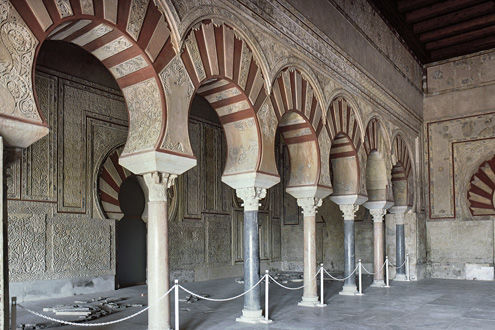In 711, less than a century after the birth of Islam, an army of Arabs and Berbers serving the Umayyad caliphs of Damascus (in Syria) landed in the Iberian Peninsula, ushering in a new phase of art and culture in the region. Within a period of seven years, most of the peninsula was under Muslim rule. These new territories came to be known by their Arabic name, al-Andalus.
In 750, the Umayyad dynasty in Syria fell to the Abbasids. The one surviving member, 'Abd al-Rahman I (reigned 756–88), escaped to Spain and established autonomous rule there. He rebuilt Córdoba, the capital city, to reflect his Syrian heritage and the Byzantine roots of the Umayyad capital of Damascus. This influence can be seen in the architecture and surface ornamentation of the Great Mosque of Córdoba as well as other buildings in the city. Under 'Abd al-Rahman III (reigned 912–61), who proclaimed himself caliph, al-Andalus grew into an empire with a diverse religious and ethnic population.

Fig. 21. Madinat al-Zahra, Spain, 953–58
From 945 to 1010, the court was centered in Madinat al-Zahra, a palace city on the outskirts of Córdoba built between 936 and 940 by 'Abd al-Rahman III. The city became synonymous with opulence and sophistication (fig. 21). It consisted of hundreds of buildings and included inns, schools, and workshops. The architecture employed columns imported from North Africa and regions in the Byzantine empire as well as marble fountains from Syria. Distinct motifs and designs, such as symmetrically arranged vegetal scrolls and complex geometric patterns, covered the surfaces of objects and were carved onto the stucco and stone walls of mosques and palaces. Works of art made in Madinat al-Zahra were products of a Mediterranean taste that drew upon indigenous traditions of Spain as well as those of the Umayyads' native Syria. Many of these masterfully crafted luxury objects, such as intricately carved ivory containers, illuminated manuscripts of the Qur'an, and lavish textiles, traveled via trade routes to other Mediterranean courts as gifts and tributes. However, the glory of the Spanish Umayyad court did not last; in 1010, Madinat al-Zahra was destroyed during a Berber revolt and its riches plundered. Many of its objects ended up in northern Europe, where they were admired, preserved, and emulated.
As a result of civil wars, Umayyad rule in Spain ended in 1031 and al-Andalus was divided among feuding city-states that faced constant attacks from northern Spanish Christian powers. Despite this upheaval, art continued to be created; artists from the Spanish Umayyad imperial workshops dispersed and their subsequent work in smaller courts ensured the survival and continuation of their outstanding craftsmanship.
| Previous Section | Next Section |